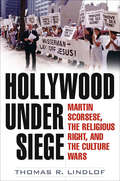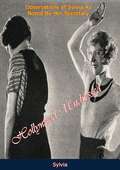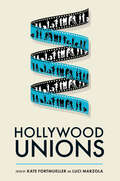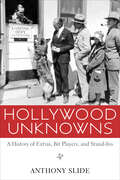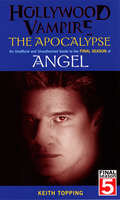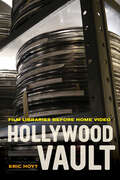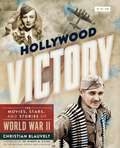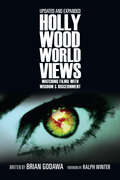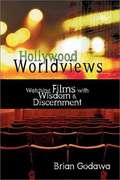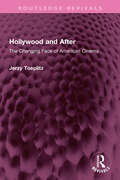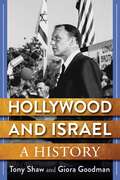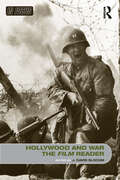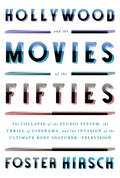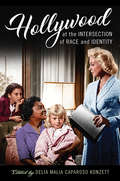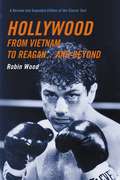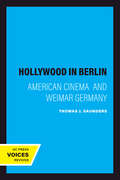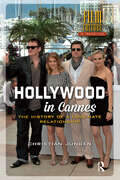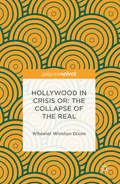- Table View
- List View
Hollywood Under Siege: Martin Scorsese, the Religious Right, and the Culture Wars
by Thomas R. LindlofA behind-the-scenes look at the making of The Last Temptation of Christ and the controversy following its release.In 1988, director Martin Scorsese fulfilled his lifelong dream of making a film about Jesus Christ. Rather than celebrating the film as a statement of faith, churches and religious leaders immediately went on the attack, alleging blasphemy. At the height of the controversy, thousands of phone calls a day flooded the Universal switchboard, and before the year was out, more than three million mailings protesting the film fanned out across the country. For the first time in history, a studio took responsibility for protecting theaters and scrambled to recruit a “field crisis team” to guide The Last Temptation of Christ through its contentious American openings. Overseas, the film faced widespread censorship actions, with thirteen countries eventually banning the film. The response in Europe turned violent when opposition groups sacked theaters in France and Greece and caused injuries to dozens of moviegoers.Twenty years later, author Thomas R. Lindlof offers a comprehensive account of how this provocative film came to be made and how Universal Pictures and its parent company MCA became targets of the most intense, unremitting attacks ever mounted against a media company. The film faced early and determined opposition from elements of the religious Right when it was being developed at Paramount during the last year the studio was run by the celebrated troika of Barry Diller, Michael Eisner, and Jeffrey Katzenberg. By the mid-1980s, Scorsese’s film was widely regarded as unmakeable?a political stick of dynamite that no one dared touch. Through the joint efforts of two of the era’s most influential executives, CAA president Michael Ovitz and Universal Pictures chairman Thomas P. Pollock, this improbable project found its way into production. The making of The Last Temptation of Christ caught evangelical Christians at a moment when they were suffering a crisis of confidence in their leadership. The religious right seized on the film as a way to rehabilitate its image and to mobilize ordinary citizens to attack liberalism in art and culture. The ensuing controversy over the film’s alleged blasphemy escalated into a full-scale war fought out very openly in the media. Universal/MCA faced unprecedented calls for boycotts of its business interests, anti-Semitic rhetoric and death threats were directed at MCA chairman Lew Wasserman and other MCA executives, and the industry faced the specter of violence at theaters.Hollywood Under Siege draws upon interviews with many of the key figures?Martin Scorsese, Paul Schrader, Michael Ovitz, Jeffrey Katzenberg, Jack Valenti, Thomas P. Pollock, and Willem Dafoe?to explore the trajectory of the film from its conception to the subsequent epic controversy and beyond. Lindlof offers a fascinating dissection of a critical episode in the embryonic culture wars, illuminating the explosive effects of the clash between the interests of the media industry and the forces of social conservatism.Praise for Hollywood Under Siege“No other book has traced the development of a major motion picture from conception through production to reception with the kind of care and detail that Lindlof does here. Hollywood Under Siege provides valuable insight into the machinery of the film industry, and into the machinations of American culture on a broader front as well.” —Thomas Schatz, author of The Genius of the System: Hollywood Filmmaking in the Studio Era and Executive Director of the University of Texas Film Institute“Riveting and accurate. Even though I thought I knew the events, I found myself captured anew.” —Paul Schrader, screenwriter and director“As a study of a landmark moment in American cinema, Lindlof’s book is both profound and extremely entertaining.” —Los Angeles Times“Lindlof has meticulously researched the histo
Hollywood Undressed: Observations Of Sylvia As Noted By Her Secretary
by SylviaIn 1932, Sylvia exposed the foibles of the Hollywood system and her illustrious clientele in the book Hollywood Undressed: Observations of Sylvia as Noted by Her Secretary (1931).It is a playful book, full of gossip and contemporary vernacular, and reveals intimate details of Sylvia’s famous Hollywood clientele, which included Jean Harlow, Marie Dressler, Mae Murray, Alice White, Bebe Daniels, Mary Duncan, Ramón Novarro, Ruth Chatterton, Ann Harding, Norma Talmadge, Grace Moore, Constance Bennett, Gloria Swanson, Nella Webb, F.W. Murnau, Elsie Janis, Ernest Torrence, Lawrence Tibbett, Laura Hope Crews, Ronald Colman, Constance Cummings, Ina Claire, John Gilbert, Carmel Myers, Helen Twelvetrees, Carole Lombard, Ilka Chase, Dorothy Mackaill, Pepi Lederer, Marion Davies, Neil Hamilton, Alan Hale Sr and Vivienne Segal.
Hollywood Unions
by Barbara Hall Helen Warner Miranda J. Banks Paul Monticone Maya Montañez Smukler Adrienne L. McLean Luci Marzola Katie Bird Kate Fortmueller Dawn Fratini Erin HillHollywood Unions is a unique collection that tells the stories of the unions and guilds that have organized motion picture and television labor: IATSE, the DGA, SAG-AFTRA, and the WGA. The Hollywood unions represent a wide swath of the workers making media: from directors and stars to grips and makeup artists. People today know some of these organizations from their glitzy annual awards celebrations, but the unions’ actual importance is in bargaining with the Association of Motion Picture and Television Producers (AMPTP) on behalf of 331,000 workers in the motion picture and television industry. The Hollywood unions are not neutral institutions but rather have long histories of jurisdictional battles, competitions with rival unions, and industry-altering strikes. They have supported the industry’s workers through the Great Depression, World War II, the McCarthy era, the collapse of the studio system, the rise of television, runaway production, fights for gender parity, the digital revolution, and a global pandemic. The history of these unions has contributed to making media work sustainable in the long term and helped shape the conditions and production cultures of Hollywood.
Hollywood Unknowns: A History of Extras, Bit Players, and Stand-Ins
by Anthony SlideExtras, bit players, and stand-ins have been a part of the film industry almost from its conception. On a personal and a professional level, their stories are told in Hollywood Unknowns, the first history devoted to extras from the silent era through the present. Hollywood Unknowns discusses the relationship of the extra to the star, the lowly position in which extras were held, the poor working conditions and wages, and the sexual exploitation of many of the hardworking women striving for a place in Hollywood society. Though mainly anonymous, many are identified by name and, for perhaps the first time, receive equal billing with the stars. And Hollywood Unknowns does not forget the bit players, stand-ins, and doubles, who work alongside the extras facing many of the same privations. Celebrity extras, silent stars who ended their days as extras, or members of various ethnic groups—all gain a deserved luster in acclaimed film writer Anthony Slide's prose. Chapters document the lives and work of extras from the 1890s to the present. Slide also treats such subjects as the Hollywood Studio Club, Central Casting, the extras in popular literature, and the efforts at unionization through the Screen Actors Guild from the 1930s onwards. Slide chronicles events such as John Barrymore's walking off set in the middle of the day so the extras could earn another day's wages, and Cecil B. DeMille's masterful organizing of casts of thousands in films such as Cleopatra. Through personal interviews, oral histories, and the use of newly available archival material, Slide reveals in Hollywood Unknowns the story of the men, women, and even animals that completed the scenes on the silver screen.
Hollywood Vampire: The Apocalypse - An Unofficial and Unauthorised Guide to the Final Season of Angel
by Keith ToppingLeaving behind his life in Sunnydale and his relationship with Buffy Sunners, Angel atones for his sins by fighting for humanity in the dark seedy underworld of the superficially glamorous city of L.A. Angel Investigations has moved from the Hyperion Hotel to running Wolfram & Hart, but has their conviction to be champions survived the upheaval?In his comprehensive unofficial guide to Season Five of Angel's world, Keith Topping, bestselling author of Slayer, the unofficial guide to Buffy, looks at each episode in turn, considering the links and cross-references between Angel and Buffy, draws attention to logic flaws, points out numerous pop-culture references and discusses recurrent themes and coverage of Angel on the Internet.This essential guide to the final season of the popular show explores the world of Angel, Wesley, Gunn, Fred, Lorne and Spike as they fight their own personal demons and the loneliness of the Big City in their search for redemption.
Hollywood Vault: Film Libraries before Home Video
by Eric HoytHollywood Vault is the story of how the business of film libraries emerged and evolved, spanning the silent era to the sale of feature libraries to television. Eric Hoyt argues that film libraries became valuable not because of the introduction of new technologies but because of the emergence and growth of new markets, and suggests that studying the history of film libraries leads to insights about their role in the contemporary digital marketplace. The history begins in the mid-1910s, when the star system and other developments enabled a market for old films that featured current stars. After the transition to films with sound, the reissue market declined but the studios used their libraries for the production of remakes and other derivatives. The turning point in the history of studio libraries occurred during the mid to late 1940s, when changes in American culture and an industry-wide recession convinced the studios to employ their libraries as profit centers through the use of theatrical reissues. In the 1950s, intermediary distributors used the growing market of television to harness libraries aggressively as foundations for cross-media expansion, a trend that continues today. By the late 1960s, the television marketplace and the exploitation of film libraries became so lucrative that they prompted conglomerates to acquire the studios. The first book to discuss film libraries as an important and often underestimated part of Hollywood history, Hollywood Vault presents a fascinating trajectory that incorporates cultural, legal, and industrial history.
Hollywood Victory: The Movies, Stars, and Stories of World War II (Turner Classic Movies)
by Christian BlauveltFrom the Turner Classic Movies Library: Film and history buffs alike will enjoy this engrossing story of Hollywood's involvement in World War II, as it's never before been told.Remember a time when all of Hollywood—with the expressed encouragement and investment of the government—joined forces to defend the American way of life? It was World War II and the gravest threat faced the nation, and the world at large. Hollywood answered the call to action.This is the riveting tale of how the film industry enlisted in the Allied effort during the second World War—a story that started with staunch isolationism as studios sought to maintain the European market and eventually erupted into impassioned support in countless ways. Industry output included war films depicting battles and reminding moviegoers what they were fighting for, "home-front" stories designed to boost the morale of troops overseas, and even musicals and comedies that did their bit by promoting the Good Neighbor Policy with American allies to the south. Stars like Carole Lombard—who lost her life returning from a war bond-selling tour—Bob Hope, and Marlene Dietrich enthusiastically joined USO performances and risked their own health and safety by entertaining troops near battlefronts; others like James Stewart and Clark Gable joined the fight themselves in uniform; Bette Davis and John Garfield created a starry haven for soldiers in their founding of the Hollywood Canteen. Filmmakers Orson Welles, Walt Disney, Alfred Hitchcock, and others took breaks from thriving careers to make films aiming to shore up alliances, boost recruitment, and let the folks back home know what beloved family members were facing overseas. Through it all, a story of once-in-a-century unity—of a collective need to stand up for humanity, even if it means risking everything—comes to life in this engrossing, photo-filled tale of Hollywood Victory.
Hollywood Worldviews: Watching Films with Wisdom and Discernment
by Brian GodawaDo you watch movies with your eyes open? You buy your tickets and concessions, and you walk into the theater. Celluloid images flash at twenty-four frames per second, and the hypnotic sequence of moving pictures coaxes you to suspend disbelief and be entertained by the implausible. Unfortunately, many often suspend their beliefs as well, succumbing to subtle lessons in how to behave, think and even perceive reality. Do you find yourself hoping that a sister will succeed in seducing her sibling's husband, that a thief will get away with his crime, that a serial killer will escape judgment? Do you, too, laugh at the bumbling priest and seethe at the intolerant and abusive evangelist? Do you embrace worldviews that infect your faith and wonder, after your head is clear, whether your faith can survive the infection? Brian Godawa guides you through the place of redemption in film, the tricks screenwriters use to communicate their messages, and the mental and spiritual discipline required for watching movies. Hollywood Worldviews helps you enter a dialogue with Hollywood that leads to a happier ending, one that keeps you aware of your culture and awake to your faith.
Hollywood and After: The Changing Face of American Cinema (Routledge Revivals)
by Jerzy ToeplitzFirst published in English in 1974, Hollywood and After presents contemporary cinema in all its complexity, describing and analyzing the various factors which, in the sixties and seventies, brought so many changes both inside Hollywood and throughout the film industry of the USA. The film industry has been restructured. No longer independent, it now forms only a part, sometimes only a small and secondary part, of large diversified corporations. Formerly rivals, today cinema and television not only coexist, but are forced to cooperate closely in a world of technical developments such as videocassettes, cable TV, and satellite transmissions. The main part of this book is dedicated to artistic and creative questions. A new generation of film makers is making films for a new generation of film goers who are looking for fresh values on the screen. More and more the cinema mirrors the reality of American life: complicated, uneasy, shaken by violent outbursts, charged with a multitude of controversies and conflicts. The rose-tinted American dream, which Hollywood peddled, is a thing of the past. Today the US cinema offers a variety of artistic, political, and social approaches and a wide range of highly individual styles. In the world of social media, OTT platforms, and AI, this book is an important historical reference for scholars and researchers of film studies, film history, and media studies.
Hollywood and Hitler, 1933-1939 (Film and Culture Series)
by Thomas DohertyBetween 1933 and 1939, representations of the Nazis and the full meaning of Nazism came slowly to Hollywood, growing more ominous and distinct only as the decade wore on. Recapturing what ordinary Americans saw on the screen during the emerging Nazi threat, Thomas Doherty reclaims forgotten films, such as Hitler's Reign of Terror (1934), a pioneering anti-Nazi docudrama by Cornelius Vanderbilt Jr.; I Was a Captive of Nazi Germany (1936), a sensational true tale of "a Hollywood girl in Naziland!"; and Professor Mamlock (1938), an anti-Nazi film made by German refugees living in the Soviet Union. Doherty also recounts how the disproportionately Jewish backgrounds of the executives of the studios and the workers on the payroll shaded reactions to what was never simply a business decision. As Europe hurtled toward war, a proxy battle waged in Hollywood over how to conduct business with the Nazis, how to cover Hitler and his victims in the newsreels, and whether to address or ignore Nazism in Hollywood feature films. Should Hollywood lie low, or stand tall and sound the alarm?Doherty's history features a cast of charismatic personalities: Carl Laemmle, the German Jewish founder of Universal Pictures, whose production of All Quiet on the Western Front (1930) enraged the nascent Nazi movement; Georg Gyssling, the Nazi consul in Los Angeles, who read the Hollywood trade press as avidly as any studio mogul; Vittorio Mussolini, son of the fascist dictator and aspiring motion picture impresario; Leni Riefenstahl, the Valkyrie goddess of the Third Reich who came to America to peddle distribution rights for Olympia (1938); screenwriters Donald Ogden Stewart and Dorothy Parker, founders of the Hollywood Anti-Nazi League; and Harry and Jack Warner of Warner Bros., who yoked anti-Nazism to patriotic Americanism and finally broke the embargo against anti-Nazi cinema with Confessions of a Nazi Spy (1939).
Hollywood and Israel: A History
by Tony Shaw Giora GoodmanFrom Frank Sinatra’s early pro-Zionist rallying to Steven Spielberg’s present-day peacemaking, Hollywood has long enjoyed a “special relationship” with Israel. This book offers a groundbreaking account of this relationship, both on and off the screen. Tony Shaw and Giora Goodman investigate the many ways in which Hollywood’s moguls, directors, and actors have supported or challenged Israel for more than seven decades. They explore the complex story of Israel’s relationship with American Jewry and illuminate how media and soft power have shaped the Arab-Israeli conflict.Shaw and Goodman draw on a vast range of archival sources to demonstrate how show business has played a pivotal role in crafting the U.S.-Israel alliance. They probe the influence of Israeli diplomacy on Hollywood’s output and lobbying activities, but also highlight the limits of ideological devotion in high-risk entertainment industries. The book details the political involvement with Israel—and Palestine—of household names such as Eddie Cantor, Kirk Douglas, Elizabeth Taylor, Barbra Streisand, Vanessa Redgrave, Arnold Schwarzenegger, Robert De Niro, and Natalie Portman. It also spotlights the role of key behind-the-scenes players like Dore Schary, Arthur Krim, Arnon Milchan, and Haim Saban.Bringing the story up to the moment, Shaw and Goodman contend that the Hollywood-Israel relationship might now be at a turning point. Shedding new light on the political power that images and celebrity can wield, Hollywood and Israel shows the world’s entertainment capital to be an important player in international affairs.
Hollywood and War, The Film Reader (In Focus: Routledge Film Readers Ser.)
by J. David SlocumDiscussing such classic films as Sergeant York, Air Force, and All Quiet on the Western Front, as well as more modern blockbusters like Apocalypse Now and Saving Private Ryan, this outstanding volume focuses on Hollywood and its production of war films.Topics covered include:the early formation of war cinemathe apotheosis of the Hollywood war filmthe ascendancy of ambivalenceHollywood and the war since Vietnamwar as a way of seeing. For any student of film studies or American cultural studies, this is a valuable companion.
Hollywood and the Culture Elite: How the Movies Became American
by Peter DecherneyPeter Decherney explores how the concerns of intellectuals and the needs of Hollywood studio heads led to the development of a mutually beneficial relationship during Hollywood's Golden Age (1915-1960). During this period, museums, universities, and government agencies used films to maintain their position as quintessential American institutions, transforming movies into an art form and making moviegoing a vital civic institution. Decherney's history features an intriguing cast of characters, including the poet Vachel Lindsay, film producers Adolph Zukor and Joseph Kennedy, Hollywood flak Will Hays, and philanthropist Nelson Rockefeller. He shows how Columbia and Harvard started film studies programs in the 1910s and 1920s to remake American education and American culture. And he shows how the Museum of Modern Art, the U.S. Office of War Information, and the National Endowment for the Arts worked with Hollywood to fight fascism and communism and to promote American values abroad. Hollywood and the Culture Elite offers a unique glimpse into the collaboration between Hollywood and the stewards of high culture to ensure their own survival and profitability.
Hollywood and the Culture Elite: How the Movies Became American (Film and Culture Series)
by Peter DecherneyAs Americans flocked to the movies during the first part of the twentieth century, the guardians of culture grew worried about their diminishing influence on American art, education, and American identity itself. Meanwhile, Hollywood studio heads were eager to stabilize their industry, solidify their place in mainstream society, and expand their new but tenuous hold on American popular culture. Peter Decherney explores how these needs coalesced and led to the development of a symbiotic relationship between the film industry and America's stewards of high culture. Formed during Hollywood's Golden Age (1915-1960), this unlikely partnership ultimately insured prominent places in American culture for both the movie industry and elite cultural institutions. It redefined Hollywood as an ideal American industry; it made movies an art form instead of simply entertainment for the masses; and it made moviegoing a vital civic institution. For their part, museums and universities used films to maintain their position as quintessential American institutions.As the book delves into the ties between Hollywood bigwigs and various cultural leaders, an intriguing cast of characters emerges, including the poet Vachel Lindsay, film producers Adolph Zukor and Joseph Kennedy, Hollywood flak and censor extraordinaire Will Hays, and philanthropist turned politician Nelson Rockefeller. Decherney considers how Columbia University's film studies program helped integrate Jewish students into American culture while also professionalizing screenwriting. He examines MoMA's career-savvy film curator Iris Barry, a British feminist once dedicated to stemming the tide of U.S. cultural imperialism, who ultimately worked with Hollywood and the U.S. government to fight fascism and communism and promote American values abroad. Other chapters explore Vachel Lindsay's progressive vision of movies as reinvigorating the public sphere through film libraries and museums; the promotion of movie connoisseurship at Harvard and other universities; and how the heir of a railroad magnate bankrolled the American avant-garde film movement. Amid ethnic diversity, the rise of mass entertainment, world war, and the global spread of American culture, Hollywood and cultural institutions worked together to insure their own survival and profitability and to provide a coherent, though shifting, American identity.
Hollywood and the Movies of the Fifties: The Collapse of the Studio System, the Thrill of Cinerama, and the Invasion of the Ultimate Body Snatcher--Television
by Foster HirschA fascinating look at Hollywood&’s most turbulent decade and the demise of the studio system—set against the boom of the post–World War II years, the Cold War, and the atomic age—and the movies that reflected the seismic shiftsHollywood in the 1950s was a period when the film industry both set conventions and broke norms and traditions—from Cinerama, CinemaScope, and VistaVision to the epic film and lavish musical. It was a decade that saw the rise of the anti-hero; the smoldering, the hidden, and the unspoken; teenagers gone wild in the streets; the sacred and the profane; the revolution of the Method; the socially conscious; the implosion of the studios; the end of the production code; and the invasion of the ultimate body snatcher: the &“small screen&” television.Here is Eisenhower&’s America—seemingly complacent, conformity-ridden revealed in Vincente Minnelli&’s Father of the Bride, Walt Disney&’s Cinderella, and Brigadoon, among others.And here is its darkening, resonant landscape, beset by conflict, discontent, and anxiety (The Man Who Knew Too Much, The Asphalt Jungle, A Place in the Sun, Touch of Evil, It Came From Outer Space) . . . an America on the verge of cultural, political and sexual revolt, busting up and breaking out (East of Eden, From Here to Eternity, On the Waterfront, Sweet Smell of Success, The Wild One, A Streetcar Named Desire, and Jailhouse Rock).An important, riveting look at our nation at its peak as a world power and at the political, cultural, sexual upheavals it endured, reflected and explored in the quintessential American art form.
Hollywood at Your Feet
by Stacey Endres Robert Cushman Ginger RogersBuilt by Sid Grauman in 1927, the most famous motion picture palace in the world towers majestically above the 6900 block of Hollywood Boulevard. The Chinese Theatre's Forecourt of the Stars attracts more than two million visitors annually. Throughout its history and up to the present day, the theatre has served as a magnet to thousands of fans and tourists who flock to the site daily to view the flamboyant architecture and the historic cement squares in the theatre's forecourt. The footprints, handprints, and signatures of 176 of Hollywood's most famous celebrities have been placed here, plus those of three comedy teams, one group of quintuplets, two robots and a villainous sci-fi character, on ventriloqist's dummy, a radio character, and the world's best known duck.
Hollywood at the Intersection of Race and Identity
by Ellen C. Scott Delia Malia Konzett Jonna Eagle Louise Wallenberg Dean Itsuji Saranillio Charlene Regester Ryan Jay Friedman Ruth Mayer Alice Maurice Matthias Konzett Chris Cagle Graham Cassano Priscilla Peña Ovalle Ernesto R Acevedo-Muñoz Mary Beltrán Jun OkadaHollywood at the Intersection of Race and Identity explores the ways Hollywood represents race, gender, class, and nationality at the intersection of aesthetics and ideology and its productive tensions. This collection of essays asks to what degree can a close critical analysis of films, that is, reading them against their own ideological grain, reveal contradictions and tensions in Hollywood’s task of erecting normative cultural standards? How do some films perhaps knowingly undermine their inherent ideology by opening a field of conflicting and competing intersecting identities? The challenge set out in this volume is to revisit well-known films in search for a narrative not exclusively constituted by the Hollywood formula and to answer the questions: What lies beyond the frame? What elements contradict a film’s sustained illusion of a normative world? Where do films betray their own ideology and most importantly what intersectional spaces of identity do they reveal or conceal?
Hollywood at the Races: Film's Love Affair with the Turf
by Alan Shuback“An informative and amusing look at the close relationship between Golden Age Hollywood and West Coast horse racing. A fascinating read.” —Christina Rice, author of Mean . . . Moody . . . Magnificent!Horse racing was so popular and influential between 1930 and 1960 that nearly 150 racing themed films were released, including A Day at the Races, Thoroughbreds Don’t Cry, and National Velvet.This fast-paced, gossipy history explores the relationship between the Hollywood film industry, the horse racing industry, and the extraordinary participation of producers, directors, and actors in the Sport of Kings. Alan Shuback details how all three of Southern California’s major racetracks were founded by Hollywood luminaries: Hal Roach was cofounder of Santa Anita Park, Bing Crosby founded Del Mar with help from Pat O’Brien, and Jack and Harry Warner founded Hollywood Park with help from dozens of people in the film community.The races also provided a social and sporting outlet for the film community—studios encouraged film stars to spend a day at the races, especially when a new film was being released. The stars’ presence at the track generated a bevy of attention from eager photographers and movie columnists, as well as free publicity for their new films. Moreover, Louis B. Mayer, Bing Crosby, Fred Astaire, Betty Grable, and Don Ameche were all major Thoroughbred owners, while Mickey Rooney, Chico Marx, and John Huston were notorious for their unsuccessful forays to the betting windows.“The more entertaining vignettes pair the names of old-time screen stars with ribald tales of racetrack depravity.” —Thoroughbred Daily News
Hollywood from Vietnam to Reagan . . . and Beyond
by Robin WoodThis classic of film criticism, long considered invaluable for its eloquent study of a problematic period in film history, is now substantially updated and revised by the author to include chapters beyond the Reagan era and into the twenty-first century. For the new edition, Robin Wood has written a substantial new preface that explores the interesting double context within which the book can be read-that in which it was written and that in which we find ourselves today. Among the other additions to this new edition are a celebration of modern "screwball" comedies like My Best Friend's Wedding, and an analysis of '90s American and Canadian teen movies in the vein of American Pie, Can't Hardly Wait, and Rollercoaster. Also included are a chapter on Hollywood today that looks at David Fincher and Jim Jarmusch (among others) and an illuminating essay on Day of the Dead.
Hollywood from Vietnam to Reagan...and Beyond: A Revised and Expanded Edition of the Classic Text
by Robin WoodThis classic of film criticism, long considered invaluable for its eloquent study of a problematic period in film history, is now substantially updated and revised by the author to include chapters beyond the Reagan era. For the new edition, Wood has included a considerable new preface, a chapter celebrating My Best Friend's Wedding, a section on 90s American teen comedies such as American Pie and Can't Hardly Wait, a chapter on Hollywood today that looks at David Fincher and Jim Jarmusch (among others), and a helpful essay on Day of the Dead.
Hollywood in Berlin: American Cinema and Weimar Germany (Weimar and Now: German Cultural Criticism #6)
by Thomas J. SaundersThe setting is 1920s Berlin, cultural heart of Europe and the era's only serious cinematic rival to Hollywood. In his engaging study, Thomas Saunders explores an outstanding example of one of the most important cultural developments of this century: global Americanization through the motion picture.The invasion of Germany by American films, which began in 1921 with overlapping waves of sensationalist serials, slapstick shorts, society pictures, and historical epics, initiated a decade of cultural collision and accommodation. On the one hand it fueled an impassioned debate about the properties of cinema and the specter of wholesale Americanization. On the other hand it spawned unprecedented levels of cooperation and exchange.In Berlin, American motion pictures not only entertained all social classes and film tastes but also served as a vehicle for American values and a source of sharp economic competition. Hollywood in Berlin correlates the changing forms of Hollywood's contributions to Weimar culture and the discourses that framed and interpreted them, restoring historical contours to a leading aspect of cultural interchange in this century. At the same time, the book successfully embeds Weimar cinema in its contemporary international setting.
Hollywood in Cannes: The History of a Love-Hate Relationship (Film Culture in Transition)
by Christian JungenConjuring up all the glamour of the event, Jungen recounts the history of the Cannes Film Festival from an American perspective surveying the complex interplay of talent, money and corporate clout. He traces the growing influence of the Hollywood studios on the festival's rise to the key film event. Case studies of film (including The Birds, Easy Rider, and The Da Vinci Code) and of the creation of stars such as Arnold Schwarzenegger and Sharon Stone, profit from the author's experience of visiting the Cannes Film Festival over more than twelve years. The translation of this work was funded by Geisteswissenschaften International Translation Funding for Work in the Humanities and Social Sciences for Germany, a joint initiative of the Fritz Thyssen Foundation, the German Federal Foreign Office, the collection society VG Wort and the Boersenverein des Deutschen Buchhandels (German Publishers & Booksellers Association.
Hollywood in Crisis or: The Collapse of the Real
by Wheeler Winston DixonThis book discusses the collapse and transformation of the Hollywood movie machine in the twenty-first century, and the concomitant social collapse being felt in nearly every aspect of society. Winston Wheeler Dixon examines key works in cinema from the era of late-stage capitalists, analyzing Hollywood films and the current wave of cinema developed outside of the Hollywood system alike. Dixon illustrates how movies and television programs across these spaces have adopted, reflected, and generated a society in crisis, and with it, a crisis for the cinematic industry itself.
Hollywood in Havana: US Cinema and Revolutionary Nationalism in Cuba before 1959
by Megan FeeneyFrom the turn of the twentieth century through the late 1950s, Havana was a locus for American movie stars, with glamorous visitors including Errol Flynn, John Wayne, and Marlon Brando. In fact, Hollywood was seemingly everywhere in pre-Castro Havana, with movie theaters three to a block in places, widely circulated silver screen fanzines, and terms like “cowboy” and “gangster” entering Cuban vernacular speech. Hollywood in Havana uses this historical backdrop as the catalyst for a startling question: Did exposure to half a century of Hollywood pave the way for the Cuban Revolution of 1959? Megan Feeney argues that the freedom fighting extolled in American World War II dramas and the rebellious values and behaviors seen in postwar film noir helped condition Cuban audiences to expect and even demand purer forms of Cuban democracy and national sovereignty. At the same time, influential Cuban intellectuals worked to translate Hollywood ethics into revolutionary rhetoric—which, ironically, led to pointed critiques and subversions of the US presence in Cuba. Hollywood in Havana not only expands our notions of how American cinema was internalized around the world—it also broadens our view of the ongoing history of US-Cuban interactions, both cultural and political.
